Contents
Guide
Published by Collins
An imprint of HarperCollinsPublishers
Westerhill Road, Bishopbriggs, Glasgow G64 2QT
www.harpercollins.co.uk
HarperCollinsPublishers
1st Floor, Watermarque Building, Ringsend Road, Dublin 4, Ireland
In association with
Royal Museums Greenwich, the group name for the National Maritime Museum, Royal Observatory Greenwich, Queens House and Cutty Sark
www.rmg.co.uk
HarperCollins Publishers 2022
Text and illustrations Storm Dunlop and Wil Tirion
Photographs see acknowledgements .
Collins is a registered trademark of HarperCollins Publishers Ltd
All rights reserved under International and Pan-American Copyright Conventions. By payment of the required fees, you have been granted the non-exclusive, non-transferable right to access and read the text of this e-book on screen. No part of this text may be reproduced, transmitted, downloaded, decompiled, reverse engineered, or stored in or introduced into any information storage and retrieval system, in any form or by any means, whether electronic or mechanical, now known or hereinafter invented, without the express written permission of HarperCollins.
The contents of this publication are believed correct at the time of creation.
Nevertheless the publisher can accept no responsibility for errors or omissions, changes in the detail given or for any expense or loss thereby caused.
HarperCollins does not warrant that any website mentioned in this title will be provided uninterrupted, that any website will be error free, that defects will be corrected, or that the website or the server that makes it available are free of viruses or bugs. For full terms and conditions please refer to the site terms provided on the website.
A catalogue record for this book is available from the British Library
If you would like to comment on any aspect of this book, please contact us at the above address or online.
e-mail:
 facebook.com/CollinsAstronomy
facebook.com/CollinsAstronomy
 @CollinsAstro
@CollinsAstro
eBook Edition September 2022
Print book ISBN 9780008393540
eBook ISBN 9780008562366
Version: 2022-06-15
This ebook contains the following accessibility features which, if supported by your device, can be accessed via your ereader/accessibility settings:
- Change of font size and line height
- Change of background and font colours
- Change of font
- Change justification
- Text to speech
Page numbers taken from the following print edition: ISBN 9780008393540
Contents
The aim of this Guide is to help people find their way around the night sky, by showing how the stars that are visible change from month to month and by including details of various events that occur throughout the year. The objects and events described may be observed with the naked eye, or nothing more complicated than a pair of binoculars.
The conditions for observing naturally vary over the course of the year. During the summer, twilight may persist throughout the night and make it difficult to see the faintest stars. There are three recognized stages of twilight: civil twilight, when the Sun is less than 6 below the horizon; nautical twilight, when the Sun is between 6 and 12 below the horizon; and astronomical twilight, when the Sun is between 12 and 18 below the horizon. Full darkness occurs only when the Sun is more than 18 below the horizon. During nautical twilight, only the very brightest stars are visible. During astronomical twilight, the faintest stars visible to the naked eye may be seen directly overhead, but are lost at lower altitudes. As the diagram shows, during June and most of July full darkness never occurs at the latitude of London, and at Edinburgh nautical twilight persists throughout the whole night, so at that latitude only the very brightest stars are visible.
Another factor that affects the visibility of objects is the amount of moonlight in the sky. At Full Moon, it may be very difficult to see some of the fainter stars and objects, and even when the Moon is at a smaller phase it may seriously interfere with visibility if it is near the stars or planets in which you are interested. A full lunar calendar is given for each month and may be used to see when nights are likely to be darkest and best for observation.
The celestial sphere
All the objects in the sky (including the Sun, Moon and stars) appear to lie at some indeterminate distance on a large sphere, centred on the Earth. This celestial sphere has various reference points and features that are related to those of the Earth. If the Earths rotational axis is extended, for example, it points to the North and South Celestial Poles, which are thus in line with the North and South Poles on Earth. Similarly, the celestial equator lies in the same plane as the Earths equator, and divides the sky into northern and southern hemispheres. Because this Guide is written for use in Britain and Ireland, the area of the sky that it describes includes the whole of the northern celestial hemisphere and those portions of the southern that become visible at different times of the year. Stars in the far south, however, remain invisible throughout the year, and are not included.

The duration of twilight throughout the year at London and Edinburgh.

Measuring altitude and azimuth on the celestial sphere.

The altitude of the North Celestial Pole equals the observers latitude.
It is useful to know some of the special terms for various parts of the sky. As seen by an observer, half of the celestial sphere is invisible, below the horizon. The point directly overhead is known as the zenith, and the (invisible) one below ones feet as the nadir. The line running from the north point on the horizon, up through the zenith and then down to the south point is the meridian. This is an important invisible line in the sky, because objects are highest in the sky, and thus easiest to see, when they cross the meridian in the south. Objects are said to transit, when they cross this line in the sky.
In this book, reference is frequently made in the text and in the diagrams to the standard compass points around the horizon. The position of any object in the sky may be described by its altitude (measured in degrees above the horizon), and its azimuth (measured in degrees from north 0, through east 90, south 180 and west 270). Experienced amateurs and professional astronomers also use another system of specifying locations on the celestial sphere, but that need not concern us here, where the simpler method will suffice.




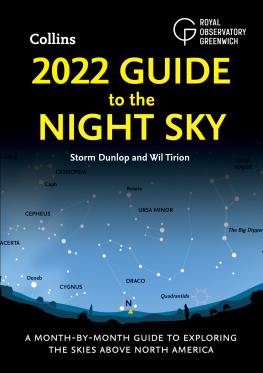
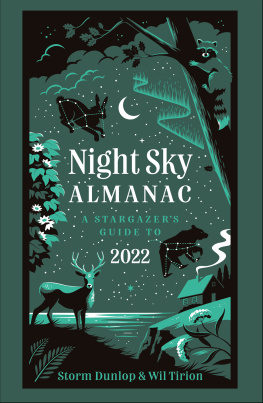
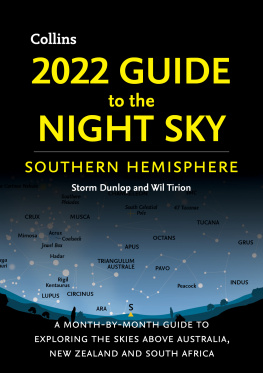
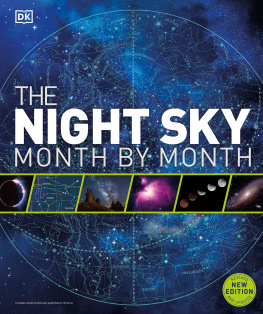
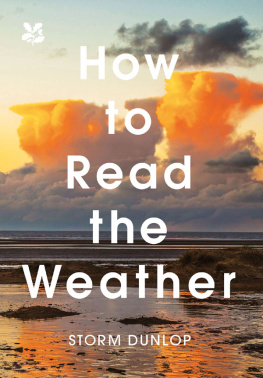
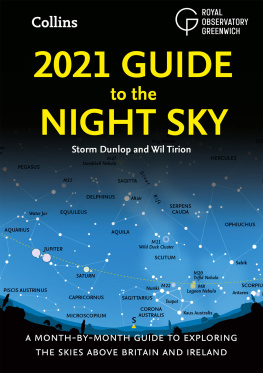



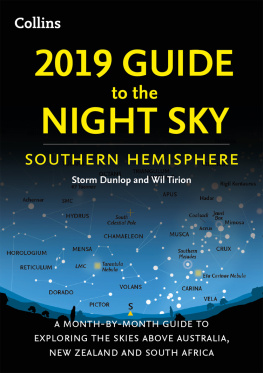


 facebook.com/CollinsAstronomy
facebook.com/CollinsAstronomy @CollinsAstro
@CollinsAstro

